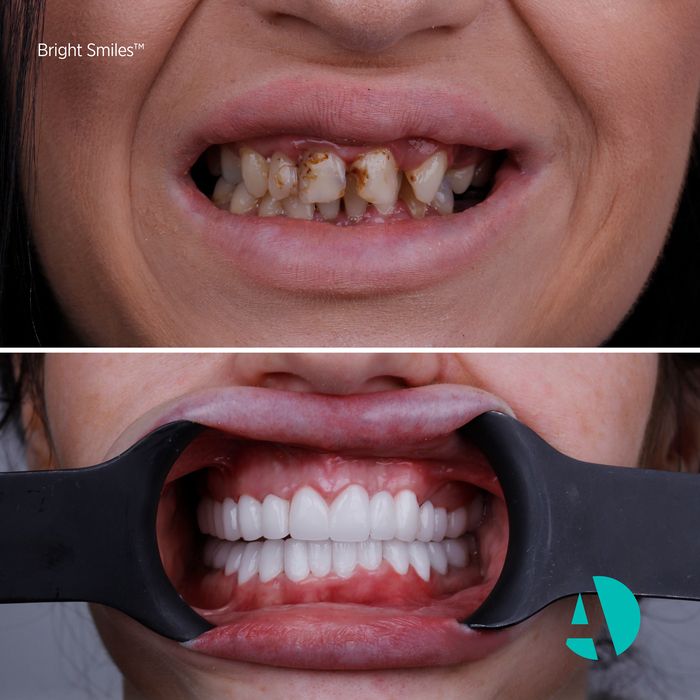What is Porcelain Crowns (PFM Crowns) treatment? What should be considered for Porcelain Crowns (PFM Crowns) dental treatment in Turkey, Antalya?
Porcelain Crowns are durable, natural-looking, and affordable crowns. Porcelain crowns are often used to cover large dental restorations. Therefore, extra costs may be requested for infected teeth, root canal treatments, or fillings. Porcelain crown prices in Turkey start from $100.
Porcelain Crowns (Porcelain Fused to Metal Crowns -PFM)
Porcelain Crowns, also known as Porcelain Fused Metal Crowns (PFM), have played an essential role in prosthetic dental treatments since the 1950s. The porcelain fused to metal restorations has the highest success rates after metal porcelain crowns in the recently published scientific studies. The Porcelain Crowns (PFM) are produced in excellent harmony through various laboratory steps and clinical reconciliations at different stages.
The inner part of the Porcelain Crown can be coated with different metal components. Yellow, green, or blue shades may occur because each component has different light transmission capacities. However, there are also metal types where a bright-white tooth color is achieved.
Free Appointment - Porcelain Crowns
You can make a free appointment below to
have porcelain crowns in Antalya.
25+
years of dental treatment experience and
professional patient services.
What Is a Porcelain Crown (PFM Crown)?
Metal-supported crowns are designed to regain the function and appearance of decayed or significantly weakened teeth. The inner part consists of a metal layer made of nickel, aluminum, or gold to meet the required resistance. They are usually preferred for posterior teeth, which are more exposed to chewing pressure. Porcelain metal crowns are also used in implant treatments as they provide satisfactory protection.
How much does a porcelain crown cost?
Porcelain Crowns are durable, natural-looking, and affordable crowns. Porcelain crowns are often used to cover large dental restorations. Therefore, extra costs may be requested for infected teeth, root canal treatments, or fillings.
Porcelain crown prices for different countries;
- United States: $1,000-$1,500
- United Kingdom: £400-£500
- Canada: $1,000-$1,200
- Turkey: $100-$200


When to use a Porcelain Crown?
Porcelain crowns are mostly preferred for highly weakened teeth through dental treatments or decays. The reasons that affect their preference the most are their robust structure and natural color-similar to the natural tooth. Porcelain crowns are also often preferred for long or short bridge treatments due to their robust structure.
Although aesthetic success is achieved in Porcelain crown, they may cause a darker gray line on the gum over time. So, they are primarily preferred in invisible areas of the mouth.
How are Porcelain Crowns made?
The standard treatment procedures for a Porcelain Crown (PFM Crown) are as follows;
- The patient's first assessment is made, and their expectations from the treatment are asked. For a successful crown treatment, the patient's expectations from the treatment and esthetic expectations for the post-treatment period should be well examined.
- After the first consultation, X-Ray and 3D examinations are made.
- According to the examinations, infected teeth, if any, are treated.
- After the filling or root canal treatments, the teeth are scraped from the upper and sides. Porcelain crowns consist of a 1mm porcelain layer and a 0.5mm metal layer. For this reason, at least 1.5 mm trimming is required on the tooth surface.
- For the construction of permanent crowns, detailed measurements are made inside the mouth, and a bite impression is taken.
- The patient is discharged with a temporary crown until permanent crowns are crafted. In most cases, dental clinics produce permanent crowns within the same day using CAD-CAM technology.

How long do Porcelain Crowns last?
Porcelain crowns are the most long-lasting crowns after metal crowns and can last for an average of 15-20 years. In porcelain crowns, the material attached to the interior can be nickel, aluminum, or gold; on the other hand, the outer part is a complete porcelain layer. Because of the porcelain structure, microscopic cracks may occur on the tooth surface, which causes stains, discoloration, or small chips over time.
Lifespan of Porcelain Crowns
The survival rate of porcelain crown over 10 years is 90%. With proper oral care, it is possible to use these crowns for 20 years or even longer. The outer porcelain layer of PFM crowns must be protected against breakage.
Which is Better, All-Porcelain Crowns or PFM Crowns
All-porcelain crowns and porcelain crowns (PFM Crowns) are assembled for entirely different purposes. In this respect, it would not be correct to evaluate which one is better. However, you can review the table below to understand the differences between the two.
| All-Porcelain Crowns | Porcelain Crowns (PFM) |
| High light transmittance capacity and natural looking | Low transmittance rate and less aesthetic appearance |
| Less resistance up to 200 Mpa | High resistance up to 1000 Mpa |
| Less life span | Longer life span |
| Designed for the frontal region | For molars and rear regions |
| Not ideal for bridges | Ideal for bridges |
| Less invasive | Invasive |
| Not expensive | Not expensive |
Porcelain Crowns (PFM Crowns) FAQ
Porcelain Crowns (PFM Crowns) - AntalyaCan You Whiten Porcelain Crowns?
It is not possible to bleach again when porcelain crowns are stained. In such cases, they should be changed depending on the level of stains.
Can Porcelain Crowns Be Shortened?
It is possible to make small restorations on porcelain crowns or veneers. But, after the treatment, they must be polished again. A cosmetic dentist must perform these procedures.
Do Porcelain Crowns Stain?
Porcelain crowns can be stained due to minor structural cracks if not cared for well. It is not possible to eliminate severe stains even with professional care.
How to Polish Porcelain Crowns at Home?
Porcelain crowns are crafted by glazing them at high temperatures, so the re-polishing of porcelain teeth does not provide the same aesthetic appearance. Polishing in home conditions can cause more harm than good because of the microscopic cracks in the porcelain. If there is a porcelain crown on the implants, the implant can be removed and re-glazed by your dental provider.
Can a Porcelain Crown Be Repaired?
When porcelain crowns (PFM) is damaged, small fractures can be repaired with composite bonding. However, the polishing process after the repairment does not provide the desired result, as it is not applied at high temperatures as with the first polishing of the crown.
Are Porcelain Crowns Safe?
PFM crowns have been at the dental stage since 1960. The metal parts are not harmful to health but may cause allergies in some patients. In such cases, it is possible to replace it with porcelain or zirconia crowns.
How Do You Care for A Porcelain Crown?
The maintenance of PFM crowns is vital because of the outer porcelain layer. They must be protected against brutal strikes. Patients should keep away from hard toothbrushes to avoid scratching the porcelain. People with teeth grinding and squeezing habits should use the night guard recommended by their dentists.
